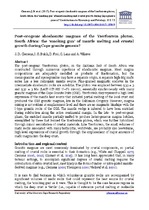| dc.contributor.author | Clemens, J.D. | |
| dc.contributor.author | Buick, I.S. | |
| dc.contributor.author | Frei, D. | |
| dc.contributor.author | Lana, C. | |
| dc.contributor.author | Villaros, A. | |
| dc.date.accessioned | 2017-08-15T13:36:34Z | |
| dc.date.available | 2017-08-15T13:36:34Z | |
| dc.date.issued | 2017 | |
| dc.identifier.citation | Clemens, J. D. et al. (2017). Post-orogenic shoshonitic magmas of the Yzerfontein pluton, South Africa: the 'smoking gun' of mantle melting and crustal growth during Cape granite genesis? Contributions to Mineralogy and Petrology, 172: 72 | en_US |
| dc.identifier.issn | 0010-7999 | |
| dc.identifier.uri | http://hdl.handle.net/10566/3123 | |
| dc.identifier.uri | http://dx.doi.org/10.1007/s00410-017-1390-9 | |
| dc.description.abstract | The post-orogenic Yzerfontein pluton, in the Saldania Belt of South Africa was constructed through numerous injections of shoshonitic magmas. Most magma compositions are adequately modelled as products of fractionation, but the monzogranites and syenogranites may have a separate origin. A separate high-Mg mafic series has a less radiogenic mantle source. Fine-grained magmatic enclaves in the intermediate shoshonitic rocks are autoliths. The pluton was emplaced between 533 ± 3 and 537 ± 3 Ma (LASF-ICP-MS U–Pb zircon), essentially synchronously with many granitic magmas of the Cape Granite Suite (CGS). Yzerfontein may represent a high-level expression of the mantle heat source that initiated partial melting of the local crust and produced the CGS granitic magmas, late in the Saldanian Orogeny. However, magma mixing is not evident at emplacement level and there are no magmatic kinships with the I-type granitic rocks of the CGS. The mantle wedge is inferred to have been enriched during subduction along the active continental margin. In the late- to post-orogenic phase, the enriched mantle partially melted to produce heterogeneous magma batches, exemplified by those that formed the Yzerfontein pluton, which was further hybridized through minor assimilation of crustal materials. Like Yzerfontein, the small volumes of mafic rocks associated with many batholiths, worldwide, are probably also lowvolume, high-level expressions of crustal growth through the emplacement of major amounts of mafic magma into the deep crust. | |
| dc.language.iso | en | en_US |
| dc.publisher | Springer Verlag | en_US |
| dc.rights | This is the author-version of the article published online at: http://dx.doi.org/10.1007/s00410-017-1390-9 | |
| dc.subject | Yzerfontein pluton | en_US |
| dc.subject | Potassic magmas | en_US |
| dc.subject | Cape granite suite | en_US |
| dc.subject | Monzonitic | en_US |
| dc.subject | Shoshonitic | en_US |
| dc.subject | Mafic magmas | en_US |
| dc.subject | U-Pb | en_US |
| dc.subject | Hf isotopes | en_US |
| dc.subject | Isotope tracing | en_US |
| dc.subject | Mantle heat | en_US |
| dc.title | Post-orogenic shoshonitic magmas of the Yzerfontein pluton, South Africa: the 'smoking gun' of mantle melting and crustal growth during Cape granite genesis? | en_US |
| dc.type | Article | en_US |
| dc.privacy.showsubmitter | FALSE | |
| dc.status.ispeerreviewed | TRUE | |
| dc.description.accreditation | ISI | |

